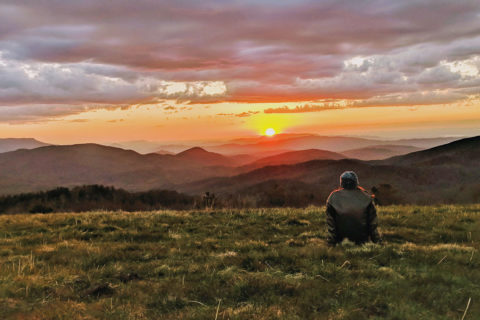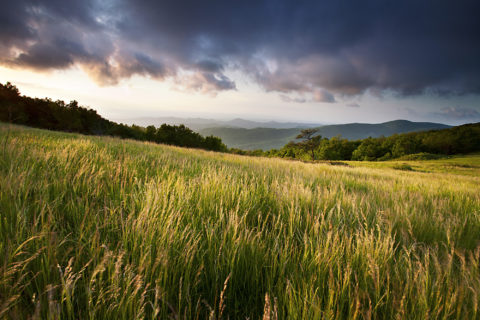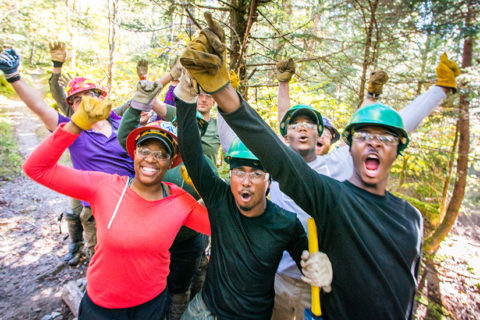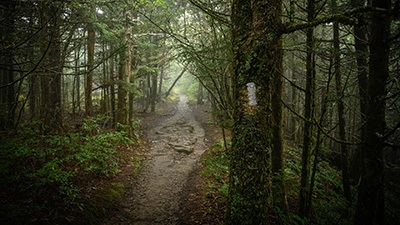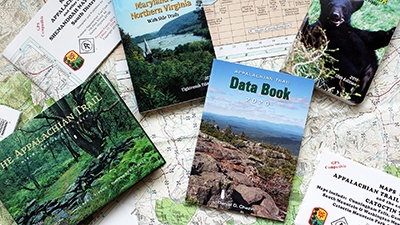BY MICHELE COLEMAN
Something to be Savored
August 12, 2022
My husband and I finished hiking the Appalachian Trail on August 31, 2012. It was a long ordeal that included ten years of section hiking. It also satisfied a dream that I had since my university days when an old boyfriend had told me about the adventure he had started with his brother. I don’t know if he ever finished the A.T. as he wanted to take his time and see some of the sites along the way, while his brother just wanted to do miles. That attitude meant nothing to me at the time, but I knew that I wanted to hike the Trail someday. My then-future husband and I bought our external frame Coleman backpacks in 1983 and hoped that we could start backpacking soon.
But life got in the way.

Michele “Loon” and Dan “Griswold” Coleman complete their section hike at Katahdin, Maine.
We finished graduate school, moved to Canada for jobs, and started a family. We were very busy, but my dream of this A.T. hike kept me going when it seemed like everything I did was for someone else. It gave me hope. It gave me a challenge. We hiked a lot with the kids, starting when most of them were only a month old. We completed a few backpacking training hikes with them starting when the youngest was four. But we soon realized that our three-to-five-kilometer days were not A.T. worthy.

From left: Julia, Nick, and Sam Coleman enjoy an afternoon at one of the A.T.’s iconic shelters.
We continued to train the kids and work out our gear kinks. The first A.T. hike was scheduled in 2001 with the kids, who were then ten, twelve, and fourteen. The days were long, the mileage short, the packs heavy with Gameboys, spare batteries, Skittles, and playing cards. The hiking monotony was overbearing for the kids. The goal was to hike far enough away from them to not hear the grumbling but close enough to make sure they wouldn’t go AWOL. We tried to make it goal orientated by knocking off a state with each trip. The tough trip was three years later, when we did 360 miles through New Jersey, New York, Massachusetts, and Vermont. They moaned because they never saw other families hiking, and, for the one that they did see, the kids looked equally miserable.
We found, over the years, that section hiking was like knowing there was a gallon of ice cream in the freezer but only allowing yourself to have a few scoops at a time. Each scoop or section was savored. Did I say savor? There was the one year it rained every day for seventeen days. There was the next year when we caught five minutes of rain the first day and then a half day of rain seventeen days later. There was the food plan, which sounded wonderful when planning but, after the fourth cycle of Mexican rice, sun-dried tomato pesto, chickpea cashew curry, chili, and refried beans with salsa and cheese, everything tasted the same. But that is not what is remembered.
WE FOUND, OVER THE YEARS, THAT SECTION HIKING WAS LIKE KNOWING THERE WAS A GALLON OF ICE CREAM IN THE FREEZER BUT ONLY ALLOWING YOURSELF TO HAVE A FEW SCOOPS AT A TIME. EACH SCOOP OR SECTION WAS SAVORED.
The kids talk about the time we met the young couple who wished them Happy Canada Day and gave them sparklers to use when they got off the Trail. And the young hiker who named our youngest “Sassafras” in New Jersey and made him feel like he was a member of the hiking community. We marvel about the “Trail angel” in Harriman State Park, who noted my husband and me in throws of indecision about what to do about our daughter “Twisted Sister’s” “sprained ankle,” which was really just a “bad attitude” sprain. The solution was to give the kids cold Cokes and shuttle my husband back to our van so that we could pull off the Trail for a few days. The miserable, wet Vermont section was salvaged by a woman who set up a BBQ at a road crossing and served hot dogs and watermelon.
We dragged each child along until they were eighteen and responsible enough to stay home on their own. We thought they would later talk about the hiking trips as Mommy Dearest kind of events. Our last child left home in 2008 and we started to experience the Trail in new ways; longer hiking days, more miles completed each trip, and less whining. Without children, hiking became a much different experience; but I sometimes missed the added antics that youth could provide.

Photo by Nancy Henderson
After the children had left us, the memories were different. Like the chance introduction to some fellow Canadians in Hot Springs, North Carolina with whom we found the two degrees of separation to someone we had known for years. We experienced the pride of hiking with a grandfather taking his oldest grandson out for his first long trip, the respect of hiking with young men just back from tours of duty and using the Trail to decompress. We met the typical recent graduates, people between careers, and retirees. We were affected by stories about ordinary people doing something extraordinary — people in their 70s and 80s — still living life and chasing their dreams to hike the Trail.
The A.T. was not just chestnut oak, oak, American chestnut, sassafras, uphill, and downhill. It was people. People from all over the world who come to hike a trail meant for all caliber of hikers. A trail set up so that you could pick it up almost anywhere and get off when you ran out of time, food, or had an injury. A trail with a system of mail drop locations and post offices for food and gear drops. A trail with a network of anonymous Trail angels who managed something as innocuous as a garbage can at a road crossing or jugs of water when springs were infrequent or dry. Then there were others who helped out by picking up hitch hikers — five grubby people who just realized that they had left their stove at the last shelter – thirteen miles back.
It was with mixed emotions that we finished the Trail. The plan was to knock off 650 miles by filling in all the uncompleted pieces; summit Springer, swing back up to summit Katahdin and then be done with the A.T. As I stood on the top of Katahdin, surveying the view from the mountain that I had only ever seen from a distance for twenty-five years, watching people pose and propose while propped on that familiar Katahdin sign, I tried to collect my emotions about how I had finished with this goal. But that’s not the thought that came to mind.
I wasn’t finishing the Trail, I was just starting it. I wanted to hike it again but in less than a ten-year span. I wanted to hike it, not in pieces by state (easiest to hardest), but as a chain from beginning to end.
“Griswold and Loon” will be back. The Trail waited for me the first time, and now that we have retired, I know it will welcome me back the next time. I feel a need to re-hike it but I also feel that great need to give back to the Trail and the incredible people who make it possible.
Last summer, we took our granddaughters on their first backpacking trip. I can now envision taking them on the Appalachian Trail. . . another generation.
This article originally appeared in the Spring/Summer 2022 issue of A.T. Journeys, the membership magazine of the ATC.
Michele and Dan Coleman have been supporting the Appalachian Trail Conservancy (ATC) for more than two decades. The Colemans reside in New Brunswick, Canada, but they can often be found enjoying long distance hiking trails like the Appalachian Trail and the Pacific Crest Trail.“The Trail gave me peace and a place to gain confidence in my worth and my values,” says Michele, explaining her desire to give back. “It made me strong. The Trail needs to be there to allow others to have the opportunity to find peace with themselves and in this world.”
The Colemans’ desire to make the world “a better place in a small way” is exemplified through their recent generous support of an Atlantic salmon habitat restoration project, led by the ATC in Maine. The ATC is currently working to aid in the return of federally endangered Atlantic salmon to Maine’s Henderson Brook. By removing a culvert and replacing it with a seventy-five-foot bridge, the ATC will eliminate the last remaining barrier to native fish passage within Henderson Brook. Additionally, fifty feet of streambed is being restored, which will reestablish natural stream hydrology and facilitate fish passage. Michele and Dan’s support is a crucial part of the success of this project.
Discover More

Stories from the Trail
Why I Hike
Each year, millions of visitors are drawn to the Appalachian Trail (A.T.) and come away with memories, photos and stories to tell.
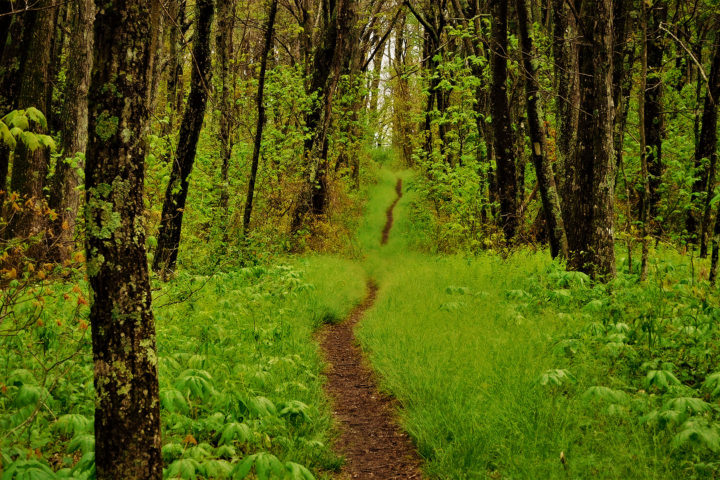
Photo Contest
Natural Beauty: 14 States, Unlimited Inspiration
Selected photos from the “Natural Beauty: 14 States, Unlimited Inspiration” photo contest, which capture the beauty and wonder of the Appalachian Trail and its surrounding lands.

ATC's Official Blog
A.T. Footpath
Learn more about ATC's work and the community of dreamers and doers protecting and celebrating the Appalachian Trail.

